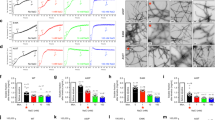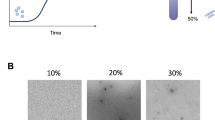Abstract
replying to J. Burré et al. Nature 498, 10.1038/nature12125 (2013)
In disagreeing with our report that native α-synuclein occurs physiologically as an α-helically folded tetramer in neural and erythroid cells1, Burré et al.2 conclude instead that ‘native brain α-synuclein’ consists of a largely unstructured monomer. They make two implications about our paper that are inaccurate: (1) that our findings pertained only to erythrocyte α-synuclein (we reported multiple experiments on neural cells); and (2) that we concluded that cellular α-synuclein is a stable tetramer under all conditions (we did not use the term ‘stable’, and we observed monomers and some other oligomers in normal cells (e.g., Fig. 1d of ref. 1)). Indeed, we emphasized the need to discover “compounds that … could kinetically stabilize native tetramers and prevent pathogenic α-synuclein aggregation”. Although the data in our report suggest that tetramers are the predominant native species, tetramers and other oligomers arise from monomers, so there must be an equilibrium between monomeric and oligomeric forms in cells. Pathogenic events (e.g., mutations) could alter this equilibrium, and some therapeutic compounds could potentially re-establish it, as we explicitly suggested1.
Similar content being viewed by others
Main
Most findings in Fig. 1 of Burré et al.2 confirm previous reports (including ours1) that recombinant α-synuclein is an unfolded monomer of ∼14 kDa but migrates anomalously at ∼60 kDa in gel filtration (their Fig. 1f), presumably owing to the large hydrodynamic radius of an extended monomer. We had stated that this made “gel filtration an unreliable indicator [of mass] and therefore [it was] not used here”1. That recombinant α-synuclein becomes α-helical upon binding phospholipid vesicles (their Fig. 1g) was also long known3 and observed by us1. The key difference from our work regards their data on the folding and assembly state of native α-synuclein (their Fig. 2). We believe these data are less in disagreement with our conclusions than the authors suggest. First, they show by size-exclusion chromatography coupled with multi-angle laser-light scattering (SEC–MALS) the existence of small amounts of α-synuclein tetramer (58.5 kDa) in their natively purified brain preparation (their Fig. 2c). Then, their Fig. 2d shows circular dichroism spectra of purified brain α-synuclein that display a mixture of unfolded (34–59%) and α-helically folded (21–24%) protein, a clear structural difference from recombinant α-synuclein, which is all unfolded (their Fig. 1g, ‘buffer’). Their findings are not entirely incompatible with our paper, as we had stated that helical tetramers were the predominant physiological species but variable amounts of monomers and other oligomers were observed1.
Given that even the helically folded tetramer suggested by us1 (and others4,5) contains only about 50% helical structure (as the regions around amino acid 50 form structured loops and the carboxy terminus is conformationally mobile), the fact that their circular dichroism spectrum contains ∼24% helical conformation suggests that up to half of their brain α-synuclein sample is folded and the other half is unfolded. The latter result raises the possibility of either differences in tetramer:monomer equilibria between their (murine brain) and our (human erythrocyte or neuroblastoma) samples or a partial denaturation of the brain sample during purification. Interestingly, room-temperature incubation of their unfolded monomeric/partly folded tetrameric sample led to overall loss of circular dichroism spectral intensity (by ∼50%), probably due to aggregation and precipitation of some of the protein out of solution, and a relative increase in helical content of the protein remaining in solution (their Fig. 2d, green). The authors correctly indicate that now their spectrum of purified brain α-synuclein is similar to our spectrum of purified erythrocyte α-synuclein. They say this conversion indicates that “purified a-synuclein aggregated in a time-dependent manner, with a relative increase in secondary structure”, but using the term ‘aggregation’ for this helical change is different from the widely studied pathogenic aggregation of α-synuclein that involves a conversion to a β-sheet-rich structure. It was the latter type of aggregation that we showed native α-synuclein to be resistant to (Fig. 3d of ref. 1). Burré et. al2 only observed loss of α-helical structure after heating brain α-synuclein to 95 °C (their Fig. 2d, orange), a condition that similarly led to denaturation of our purified α-synuclein helical tetramers (Supplementary Fig. 11 of ref. 1) and thus does not disprove our conclusion that native helical α-synuclein does not readily aggregate under physiological conditions.
The loss of overall circular dichroism signal accompanied by an increase in α-helical spectral components that Burré et al.2 show in Fig. 2d could be interpreted in two ways: (1) some sample precipitation occurs, and at the same time the remaining soluble α-synuclein becomes increasingly α-helically folded (such an event could be interpreted as the refolding of a partially denatured protein); or (2) the monomeric, unfolded portion of the mixture (their Fig. 2c) aggregates and precipitates out of solution (their Fig. 2e), whereas the helically folded, apparently tetrameric component (their Fig. 2c) stays unaltered in solution and provides the circular dichroism signal. The latter interpretation would be consistent with our hypothesis that destabilization of helical tetramers into unfolded monomers in cells may precede pathological α-synuclein aggregation1. In summary, the difference between their purified brain α-synuclein and our purified erythrocyte and neuroblastoma α-synuclein seems to be the relative abundance of the aggregation-resistant helical material at the time of initial analysis.
Even though the dynamic light scattering data of Burré et al.2 in Fig. 2e imply an increasing amount of aggregates (in agreement with the partial precipitation suggested in their Fig. 2d), no conclusion about the amount of remaining monomers/tetramers in the sample can be drawn from this, given the inability of dynamic light scattering to detect small particles if sufficient amounts of large particles are present in the mixture.
Collectively, the data of Burré et al.2 show the existence of some helically folded, apparently tetrameric (58.5 kDa) protein in purified α-synuclein isolated from normal mouse brain, although in their hands, this constitutes only half (by their Fig. 2d) or a minor portion (by their Fig. 2c) of their total protein immediately after purification and only becomes the major species upon incubation over time (their Fig. 2d). Given that the two studies are therefore debating the relative proportion under native conditions of helically folded tetramers, not their existence per se, we believe it is reasonable to pursue attempts to stabilize helically folded native α-synuclein tetramers as an approach to reducing the pathological aggregation of monomers. In light of our findings in Bartels et al.1 and in an extensive α-synuclein crosslinking analysis in intact neurons and other cells6, the combined recent data support the hypothesis that physiological α-synuclein occurs in cells in an oligomeric (principally tetrameric) state in the cytosol1,4,5,6 which is in equilibrium with unfolded monomers.
This Reply is written by two out of three of the authors from the original paper1. J. G. Choi left the laboratory for Graduate School in 2011.
References
Bartels, T., Choi, J. G. & Selkoe, D. J. α-Synuclein occurs physiologically as a helically folded tetramer that resists aggregation. Nature. 477, 107–110 (2011)
Burré, J. et al. α-Synuclein in brain cytosol is monomeric. Nature 498, http://dx.doi.org/10.1038/nature12125 (2013)
Davidson, W. S., Jonas, A., Clayton, C. F. & George, J. M. Stabilization of α-Synuclein secondary structure upon binding to synthetic membranes. J. Biol. Chem. 273, 9443–9449 (1998)
Wang, W. et al. A soluble α-synuclein construct forms a dynamic tetramer. Proc. Natl Acad. Sci. USA. 108, 17797–17802 (2011)
Westphal, C. H. & Chandra, S. S. Monomeric synucleins generate membrane curvature. J. Biol. Chem. 288, 1829–1840 (2013)
Dettmer, U., Newman, A. J., Luth, E. S., Bartels, T. & Selkoe, D. In vivo crosslinking reveals principally oligomeric forms of α-synuclein and β-synuclein in neurons and non-neural cells. J. Biol. Chem. 288, 6371–6385 (2013)
Author information
Authors and Affiliations
Corresponding author
Rights and permissions
About this article
Cite this article
Bartels, T., Selkoe, D. Bartels & Selkoe reply. Nature 498, E6–E7 (2013). https://doi.org/10.1038/nature12126
Published:
Issue Date:
DOI: https://doi.org/10.1038/nature12126
This article is cited by
-
Amyloid β-protein oligomers and Alzheimer’s disease
Alzheimer's Research & Therapy (2013)
Comments
By submitting a comment you agree to abide by our Terms and Community Guidelines. If you find something abusive or that does not comply with our terms or guidelines please flag it as inappropriate.



